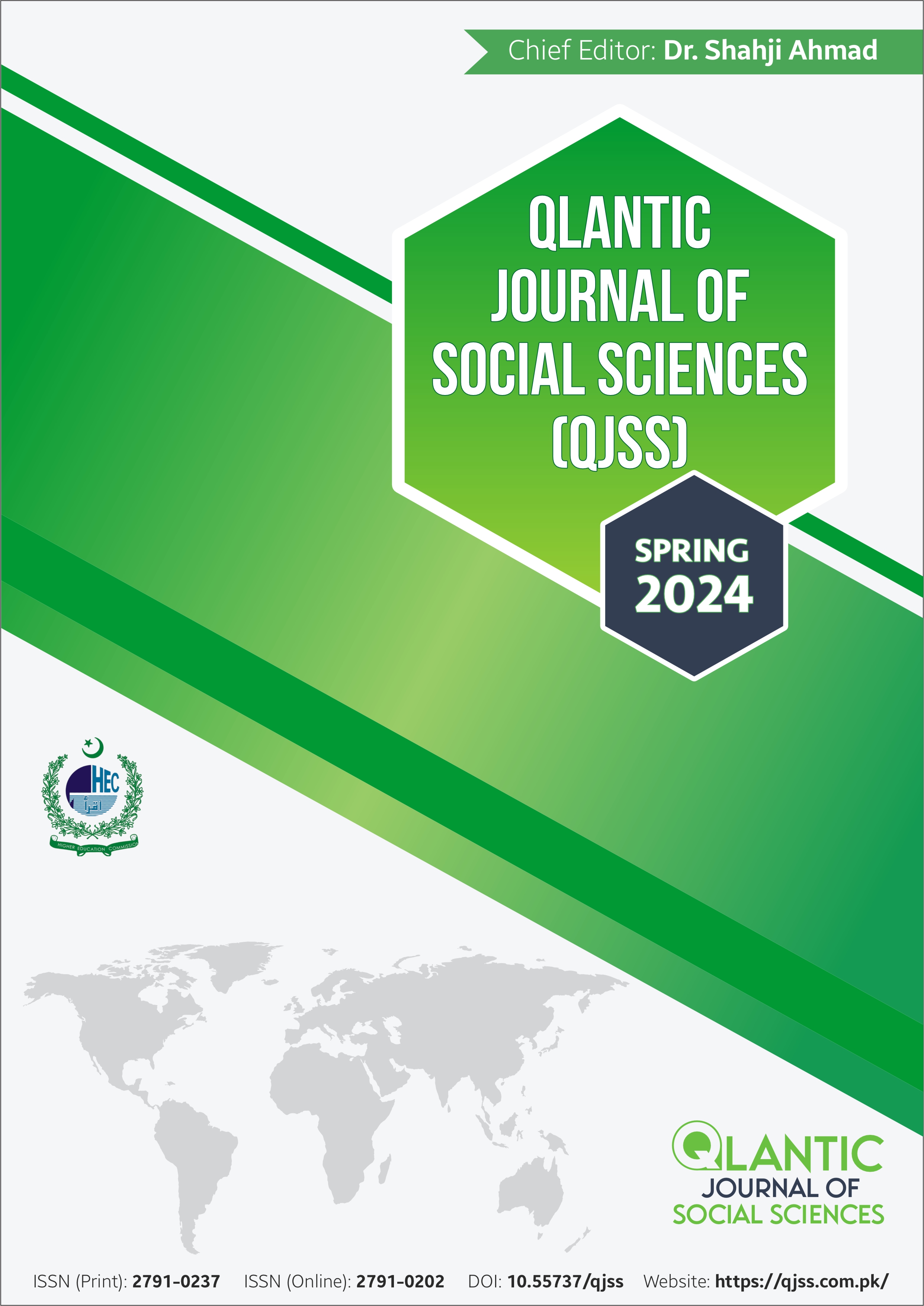Assessing Intercultural Competence in Pakistani Students: An Analysis of O-Level English Language Examination
DOI:
https://doi.org/10.55737/qjss.619679389Keywords:
Cambridge International Examination (CIE), intercultural Competence, English Language Exam, Globalization, Linguistic CompetenceAbstract
This paper explores the intercultural competence of Pakistani students who appear in Cambridge O-Level English language examination conducted in Pakistan by British council twice a year. English language is a core subject and is coded with 1123 for Cambridge International Examination (CIE). For this subject, two papers are taken i.e. paper-I was about reading comprehension and paper-II was about writing a composition. To analyze the extent to which intercultural competence assesses alongside linguistic competence amongst students through exam papers, forty-four exam papers (2013-2023) are analyzed by using Byram’s (1993) checklist that constitutes eight categories of intercultural competence. Fairclough’s (2003) model of discourse analysis has been used as a theoretical framework. For analytical framework, topics, themes, and the content of both the papers are thoroughly read and then are put under the eight categories of assessing intercultural competence proposed by Byram (1993). The findings of one-sample t-test indicate that the categories of Byram’s checklist have negative effect on the content of the papers of O-Level. The results clearly display the absence of assessment of intercultural competence of students because less content on local culture was given in the exam papers.
References
Alizadeh, S., & Chavan, M. (2015). Cultural competence dimensions and outcomes: A systematic review of the literature. Health & Social Care in the Community, 24(6), e117-e130. https://doi.org/10.1111/hsc.12293
Alptekin, C. (2002). Towards intercultural communicative competence in ELT. ELT Journal, 56(1), 57-64. https://doi.org/10.1093/elt/56.1.57
Balcazar, F. E., Suarez-Balcazar, Y., & Taylor-Ritzler, T. (2009). Cultural competence: Development of a conceptual framework. Disability and Rehabilitation, 31(14), 1153-1160. https://doi.org/10.1080/09638280902773752
Byram, M. (1989). Cultural studies in Foreign Language education. Multilingual Matters.
Byram, M. (1993). Language and culture learning: The need for integration. Germany, its representation in textbooks for teaching German in Great Britain, 3-16
Byram, M. (2020). Teaching and assessing intercultural communicative competence: Revisited. Multilingual matters.
Darling, D. A. (1957). The Kolmogorov-Smirnov, Cramer-von mises tests. The Annals of Mathematical Statistics, 28(4), 823-838. https://doi.org/10.1214/aoms/1177706788
Deardorff, D.K., & Berardo, K. (Eds.). (2012). Building Cultural Competence: Innovative Activities and Models (1st ed.). Routledge. https://doi.org/10.4324/9781003443322
Deardorff, D. K. (2011). Assessing intercultural competence. New Directions for Institutional Research, 2011(149), 65-79. https://doi.org/10.1002/ir.381
Fairclough, N. (2003). Analysing discourse (Vol. 270). London: Routledge.
Faraz, H., & Shahzad, K. (2023). Video Game Stereotypes and their Impact on Language and Culture in Pakistan. Erevna: Journal of Linguistics and Literature, 7(1), 61-74. https://journals.au.edu.pk/ojserevna/index.php/erevna/article/view/284
Gay, G. (2013). The importance of multicultural education. In Curriculum Studies Reader E2 (pp. 312-318). Routledge.
Gillespie, V. (2019). Unheard Voices: Student Perceptions About Cultural Competence In The Independent School Classroom, [All Theses And Dissertations]. 220. https://dune.une.edu/theses/220
Habib, A., & Saleem, M. (2016). The construction of national and Muslim identities through academic discourse. Tahdhīb al Afkār, 3(2), 19-28.
Hinkel, E. (2005). Analyses of second language text and what can be learned from them. In Handbook of research in second language teaching and learning (pp. 615-628). Routledge.
Holliday, A. (2021). Intercultural communication: An advanced resource book for students. Routledge.
Jenkins, H. (2006). 5. Why Heather Can Write: Media Literacy and the Harry Potter Wars. In Convergence Culture (pp. 169-205). New York University Press.
Kaihlanen, A., Hietapakka, L., & Heponiemi, T. (2019). Increasing cultural awareness: qualitative study of nurses’ perceptions about cultural competence training. BMC Nursing, 18(1). https://doi.org/10.1186/s12912-019-0363-x
Kaya, A. (2017). Examining the integration of intercultural communicative competence in ESL/EFL textbooks [Master's thesis]. Eğitim Bilimleri Enstitüsü.
Kramsch, C. (2013). Culture in foreign language teaching. Iranian journal of language teaching research, 1(1), 57-78. https://files.eric.ed.gov/fulltext/EJ1127430.pdf
Ladner, S. M. (2019). Cultural Competence of Elementary Teachers: Acquisition and Effective Transfer to Student Learning [Doctoral dissertation]. Northcentral University.
Lim, L. (2012). Ideology, class and rationality: A critique of Cambridge International Examinations’Thinking Skillscurriculum. Cambridge Journal of Education, 42(4), 481-495. https://doi.org/10.1080/0305764x.2012.733342
Lim, L. (2011). Beyond logic and argument analysis: Critical thinking, everyday problems and democratic deliberation in Cambridge international examinations’ thinking skills curriculum. Journal of Curriculum Studies, 43(6), 783-807. https://doi.org/10.1080/00220272.2011.590231
Nieto, S. (2001). Language, culture, and teaching: Critical perspectives. Routledge.
Razali, N. M., & Wah, Y. B. (2011). Power comparisons of shapiro-wilk, kolmogorov-smirnov, lilliefors and anderson-darling tests. Journal of statistical modeling and analytics, 2(1), 21-33. https://www.nrc.gov/docs/ML1714/ML17143A100.pdf
Rosenblatt, P. C. (2016). Cultural competence and humility. Handbook of social justice in loss and grief. New York: Routledge, 67-74.
Scherr, A. (2007). 15. Schools and cultural difference. In H. Kotthoff & H. Spencer-Oatey (Ed.), Handbook of Intercultural Communication (pp. 303-322). Berlin, New York: De Gruyter Mouton. https://doi.org/10.1515/9783110198584.3.303
Shen, Z. (2014). Cultural competence models and cultural competence assessment instruments in nursing. Journal of Transcultural Nursing, 26(3), 308-321. https://doi.org/10.1177/1043659614524790
Shliakhovchuk, E. (2019). After cultural literacy: New models of intercultural competency for life and work in a VUCA world. Educational Review, 73(2), 229-250. https://doi.org/10.1080/00131911.2019.1566211
Weir, C. J. (2019). Global, Local, or “Glocal”: Alternative pathways in English language test provision. In English Language Proficiency Testing in Asia (pp. 193-225). Routledge.




